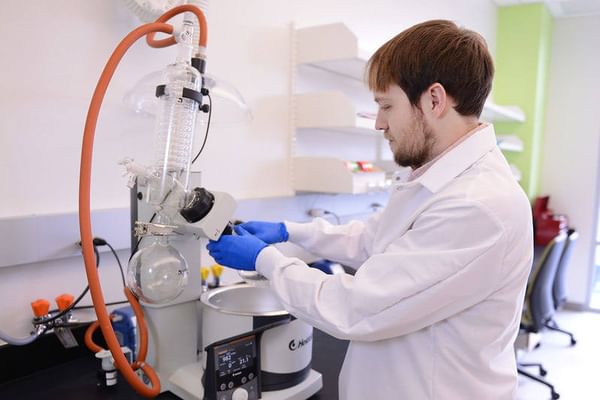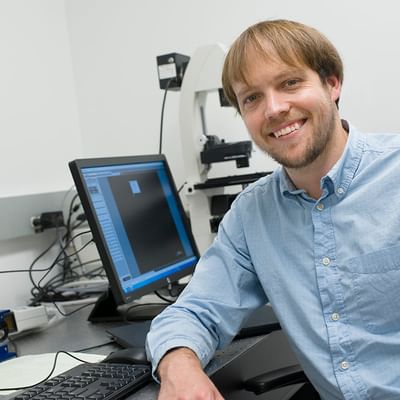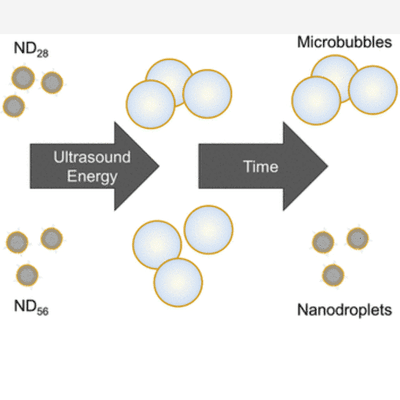- Undergraduate
Bachelor's Degrees
Bachelor of ArtsBachelor of EngineeringDual-Degree ProgramUndergraduate AdmissionsUndergraduate Experience
- Graduate
Graduate Experience
- Research
- Entrepreneurship
- Community
- About
-
Search

Geoffrey P. Luke
Associate Professor of Engineering

Professor Luke uses the rotary evaporator for nanoparticle synthesis at the Williamson Translational Research Building. (Photo by Kathryn LoConte Lapierre)
Research Interests
Ultrasound imaging; photoacoustic imaging; bionanotechnology; cancer diagnostics and therapy; molecular imaging
Education
- BS, Computer Engineering and Mathematics, University of Wyoming 2007
- MS, Electrical Engineering, University of Wyoming 2009
- PhD, Electrical Engineering, The University of Texas at Austin 2013
Research Projects
-
Super-resolution ultrasound imaging
Super-resolution ultrasound imaging
The resolution of ultrasound imaging is typically determined by the wavelength of sound. We are circumventing this limitation with a new class of phase change nanoparticle contrast agents, called laser-activated nanodetectors (LANDs). These contrast agents, which consist of a liquid perfluorocarbon core and encapsulated dye, undergo vaporization upon exposure to pulsed laser irradiation. Several milliseconds later, the LANDs recondense back to their stable liquid state. While in their gaseous state, the LANDs provide high contrast in ultrasound images. The end result is a triggerable "blinking" contrast agent. We are currently developing algorithms to harness the blinking to improve the resolution of the imaging system as well as probe the tissue properties.
-
Translational photoacoustic imaging
Translational photoacoustic imaging
Photoacoustic imaging is a hybrid technique which relies on a pulsed laser to generate acoustic waves within tissue. It is capable of achieving high resolution images with optical contrast tens of millimeters deep in tissue. We are working to translate this technology to the clinic with an initial focus on identifying metastatic lymph nodes in breast cancer patients. This project involves the development of the imaging system, creation of spectroscopic imaging algorithms, and combining the two for imaging in the clinic.
Selected Publications
- GP Luke and SY Emelianov, “Label free detection of lymph node metastases with ultrasound-guided functional photoacoustic imaging,” Radiology, (Published online).
- GP Luke, JN Myers, SY Emelianov, and KV Sokolov, “Sentinel lymph node biopsy revisited: ultrasound-guided photoacoustic detection of micrometastases using molecularly targeted plasmonic nanosensors,” Cancer Research, volume 74, issue 19, 2014.
- S Kim, Y-S Chen, GP Luke, and SY Emelianov, “In-vivo ultrasound and photoacoustic image-guided photothermal cancer therapy using silica-coated gold nanorods,” IEEE Trans. Ultrason., Ferroelectr., Freq. Control, volume 61, issue 9, 2014.
- GP Luke and SY Emelianov, “Optimization of in vivo spectroscopic photoacoustic imaging by smart optical wavelength selection,” Optics Letters, volume 39, issue 7, 2014.
- AS Hannah, GP Luke, KA Wilson, KA Homan, and SY Emelianov, “Optically-triggered vaporization of ICG-loaded perfluorocarbon nanodroplets for enhanced ultrasound and photoacoustic imaging,” ACS Nano, volume 8, number 1, 2014.
- GP Luke, A Bashyam, KA Homan, S Makhija, Y-S Chen, and SY Emelianov, “Silica-coated gold nanoplates as stable photoacoustic contrast agents for sentinel lymph node imaging,” Nanotechnology, volume 24, number 45, 2013.
- GP Luke, SY Nam, and SY Emelianov, “Optical wavelength selection for improved spectroscopic photoacoustic imaging,” Photoacoustics, volume 1, issue 2, 2013.
- GP Luke, DY Yeager, and SY Emelianov, “Biomedical applications of photoacoustic imaging with exogenous contrast agents” Annals of Biomedical Engineering, volume 40, number 2, pp. 422-437, 2012.
- S Kim, Y-S Chen, GP Luke, and SY Emelianov, “In vivo three-dimensional spectroscopic photoacoustic imaging for monitoring nanoparticle delivery.” Biomedical Optics Express, volume 2, issue 9, 2011.
- S Mallidi, GP Luke, and S Emelianov, “Role of photoacoustic imaging in cancer detection, diagnosis, and treatment guidance,” Trends in Biotechnology, volume 29 issue 5, 2011.
News







